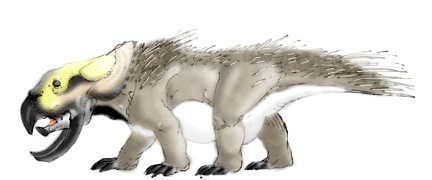

A poorly understood denizen of the Amazon Rainforest, the till-cheeked dinoceratopsid is known from a single water-damaged skin and parts of a skull collected from a jagular's nest, in the heart of the jungle. The skull fragments consisted of parts of a hooked, parrot-like beak, a curved jugal horn (a characteristic of some dinoceratopsid species), and the lowslung frill. The skin was damaged badly be water, rot, and the jagular, but it indicates an animal perhaps two meters long, with short limbs and a large belly. Most intriguing are a number spines, formed of elongated scutes, which were found attached to the skin near the tail and base of the neck. Close examination of the skin revealed holes where more of these spines had once grown, indicating a porcupine-like coat of quills that extended across the till-cheek's back. Above is a reconstruction based upon the skin and skull fragments, showing the armor of quills and the jugal horns, which have earned this species its unofficial nick-name.Immediately, connections were drawn between this animal, and another poorly-known dinoceratopsid, the tusk-frill. However, since neither species is based upon a reliable type specimen, both must be considered dinoceratopsidae interce sedis.